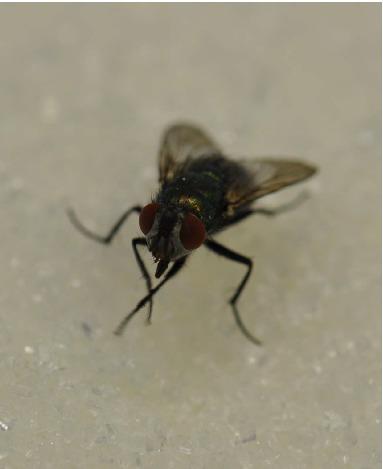当前位置:
X-MOL 学术
›
Med. Vet. Entomol.
›
论文详情
Our official English website, www.x-mol.net, welcomes your
feedback! (Note: you will need to create a separate account there.)
Nutritional requirements for reproduction and survival in the blowfly Lucilia sericata.
Medical and Veterinary Entomology ( IF 1.6 ) Pub Date : 2019-12-17 , DOI: 10.1111/mve.12425 S Alqurashi 1, 2 , S English 1 , R Wall 1
Medical and Veterinary Entomology ( IF 1.6 ) Pub Date : 2019-12-17 , DOI: 10.1111/mve.12425 S Alqurashi 1, 2 , S English 1 , R Wall 1
Affiliation

|
Insects with access to finite energy resources must allocate these between maintenance and reproduction in a way that maximizes fitness. This will be influenced by a range of life-history characteristics and the environment in which any particular insect species lives. In the present study, females of the blowfly Lucilia sericata (Diptera: Calliphoridae) were fed diets differing in protein and carbohydrate (sucrose) content and the allocation of lipid to reproduction was quantified using a spectrophotometric method of analysis. Immediately after adult emergence, total body lipid, scaled for differences in body size, showed an initial decline as it was utilized to meet the metabolic demands of cuticle deposition, muscle maturation and then flight. When flies were denied access to sucrose, stored lipid then continued to decrease until flies died, usually within 4 days of emergence. However, flies given access to sucrose were able to increase body lipid content, demonstrating that carbohydrate is essential for homeostasis and that it can be used to synthesize lipid. Nevertheless, female flies fed sucrose only were unable to synthesize egg yolk. Only flies provided with protein were able to mature eggs. However, the rate of egg maturation and number and size of eggs matured were greater for female flies given liver compared with flies provided with pure whey protein powder. The results demonstrate the importance of different dietary components for different elements of the life-history of L. sericata, namely survival and reproduction.
中文翻译:

蝇LucLucic sericata繁殖和生存的营养需求。
拥有有限能源的昆虫必须以最大化适应性的方式在维护和繁殖之间分配这些能量。这将受到一系列生命历史特征和任何特定昆虫物种生活环境的影响。在本研究中,给蝇蝇(Lucilia sericata)(双翅目:Calliphoridae)的雌性饲喂蛋白质和碳水化合物(蔗糖)含量不同的饮食,并使用分光光度法分析定量了脂质对生殖的分配。成年后,随体表大小变化而变化的总体内脂质立即显示出最初的下降,因为它被用来满足角质层沉积,肌肉成熟以及随后飞行所需的代谢。当果蝇被拒绝食用蔗糖时,储存的脂质随后会继续下降,直到果蝇死亡,通常在出现后4天内。但是,获得蔗糖的果蝇能够增加体内脂质含量,这表明碳水化合物对于体内稳态是必不可少的,并且可以用于合成脂质。然而,仅饲喂蔗糖的雌蝇无法合成蛋黄。只有提供蛋白质的果蝇才能使卵成熟。但是,与提供纯乳清蛋白粉的蝇相比,有肝脏的雌蝇的卵成熟率和成熟卵的数量和大小更大。结果表明,不同饮食成分对绢丝线虫生活史的不同要素(即生存和繁殖)的重要性。证明碳水化合物对于体内平衡是必不可少的,并且可以用于合成脂质。然而,仅饲喂蔗糖的雌蝇无法合成蛋黄。只有提供蛋白质的果蝇才能使卵成熟。但是,与提供纯乳清蛋白粉的蝇相比,有肝脏的雌蝇的卵成熟率和成熟卵的数量和大小更大。结果表明,不同饮食成分对绢丝线虫生活史的不同要素(即生存和繁殖)的重要性。证明碳水化合物对于体内平衡是必不可少的,并且可以用于合成脂质。然而,仅饲喂蔗糖的雌蝇无法合成蛋黄。只有提供蛋白质的果蝇才能使卵成熟。但是,与提供纯乳清蛋白粉的蝇相比,有肝脏的雌蝇的卵成熟率和成熟卵的数量和大小更大。结果表明,不同饮食成分对于丝纹线虫生活史的不同要素(即生存和繁殖)的重要性。与提供纯乳清蛋白粉的果蝇相比,有肝脏的雌性果蝇的卵成熟率和成熟卵的数量和大小更大。结果表明,不同饮食成分对绢丝线虫生活史的不同要素(即生存和繁殖)的重要性。与提供纯乳清蛋白粉的果蝇相比,有肝脏的雌性果蝇的卵成熟率和成熟卵的数量和大小更大。结果表明,不同饮食成分对绢丝线虫生活史的不同要素(即生存和繁殖)的重要性。
更新日期:2019-12-17
中文翻译:

蝇LucLucic sericata繁殖和生存的营养需求。
拥有有限能源的昆虫必须以最大化适应性的方式在维护和繁殖之间分配这些能量。这将受到一系列生命历史特征和任何特定昆虫物种生活环境的影响。在本研究中,给蝇蝇(Lucilia sericata)(双翅目:Calliphoridae)的雌性饲喂蛋白质和碳水化合物(蔗糖)含量不同的饮食,并使用分光光度法分析定量了脂质对生殖的分配。成年后,随体表大小变化而变化的总体内脂质立即显示出最初的下降,因为它被用来满足角质层沉积,肌肉成熟以及随后飞行所需的代谢。当果蝇被拒绝食用蔗糖时,储存的脂质随后会继续下降,直到果蝇死亡,通常在出现后4天内。但是,获得蔗糖的果蝇能够增加体内脂质含量,这表明碳水化合物对于体内稳态是必不可少的,并且可以用于合成脂质。然而,仅饲喂蔗糖的雌蝇无法合成蛋黄。只有提供蛋白质的果蝇才能使卵成熟。但是,与提供纯乳清蛋白粉的蝇相比,有肝脏的雌蝇的卵成熟率和成熟卵的数量和大小更大。结果表明,不同饮食成分对绢丝线虫生活史的不同要素(即生存和繁殖)的重要性。证明碳水化合物对于体内平衡是必不可少的,并且可以用于合成脂质。然而,仅饲喂蔗糖的雌蝇无法合成蛋黄。只有提供蛋白质的果蝇才能使卵成熟。但是,与提供纯乳清蛋白粉的蝇相比,有肝脏的雌蝇的卵成熟率和成熟卵的数量和大小更大。结果表明,不同饮食成分对绢丝线虫生活史的不同要素(即生存和繁殖)的重要性。证明碳水化合物对于体内平衡是必不可少的,并且可以用于合成脂质。然而,仅饲喂蔗糖的雌蝇无法合成蛋黄。只有提供蛋白质的果蝇才能使卵成熟。但是,与提供纯乳清蛋白粉的蝇相比,有肝脏的雌蝇的卵成熟率和成熟卵的数量和大小更大。结果表明,不同饮食成分对于丝纹线虫生活史的不同要素(即生存和繁殖)的重要性。与提供纯乳清蛋白粉的果蝇相比,有肝脏的雌性果蝇的卵成熟率和成熟卵的数量和大小更大。结果表明,不同饮食成分对绢丝线虫生活史的不同要素(即生存和繁殖)的重要性。与提供纯乳清蛋白粉的果蝇相比,有肝脏的雌性果蝇的卵成熟率和成熟卵的数量和大小更大。结果表明,不同饮食成分对绢丝线虫生活史的不同要素(即生存和繁殖)的重要性。











































 京公网安备 11010802027423号
京公网安备 11010802027423号